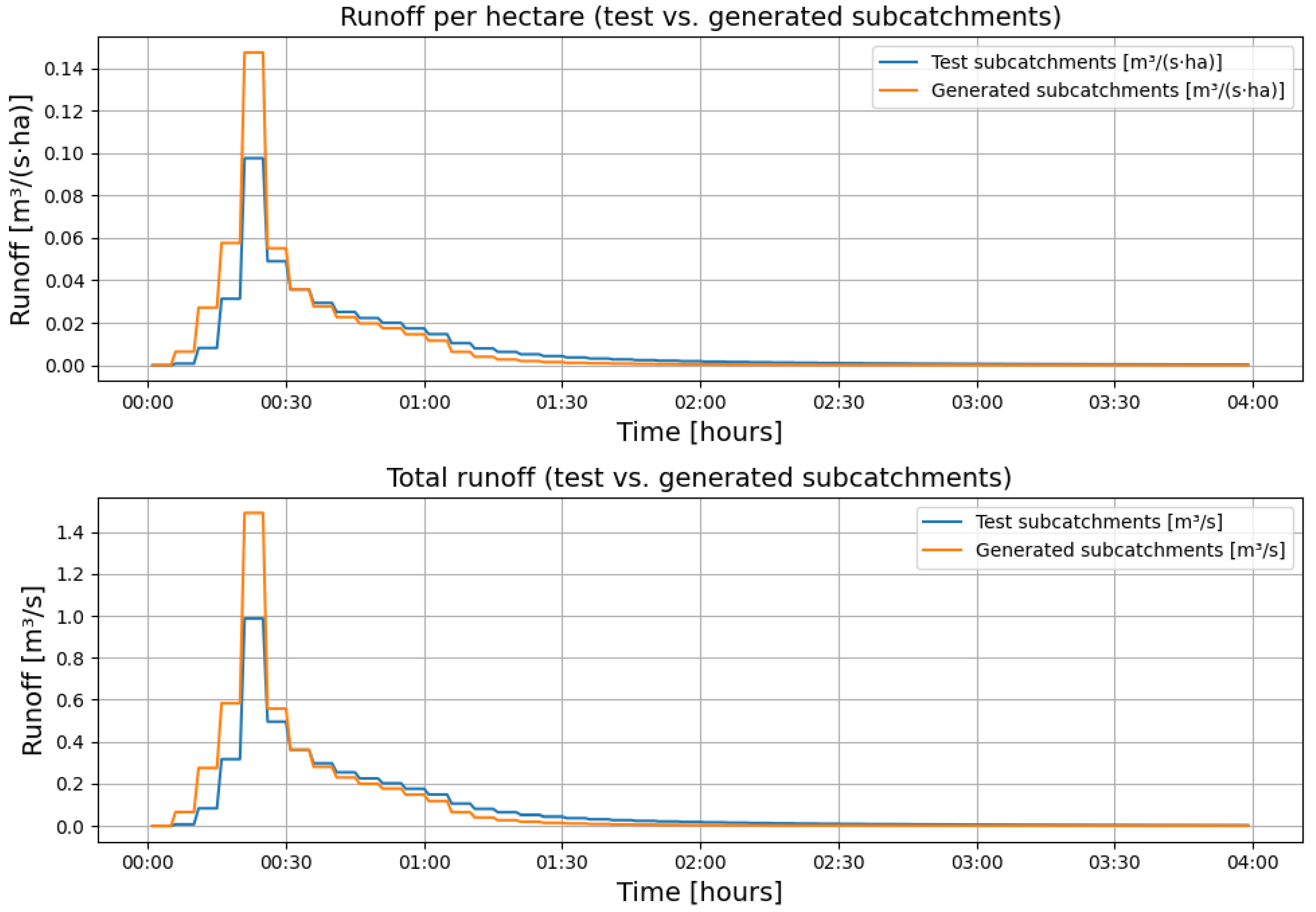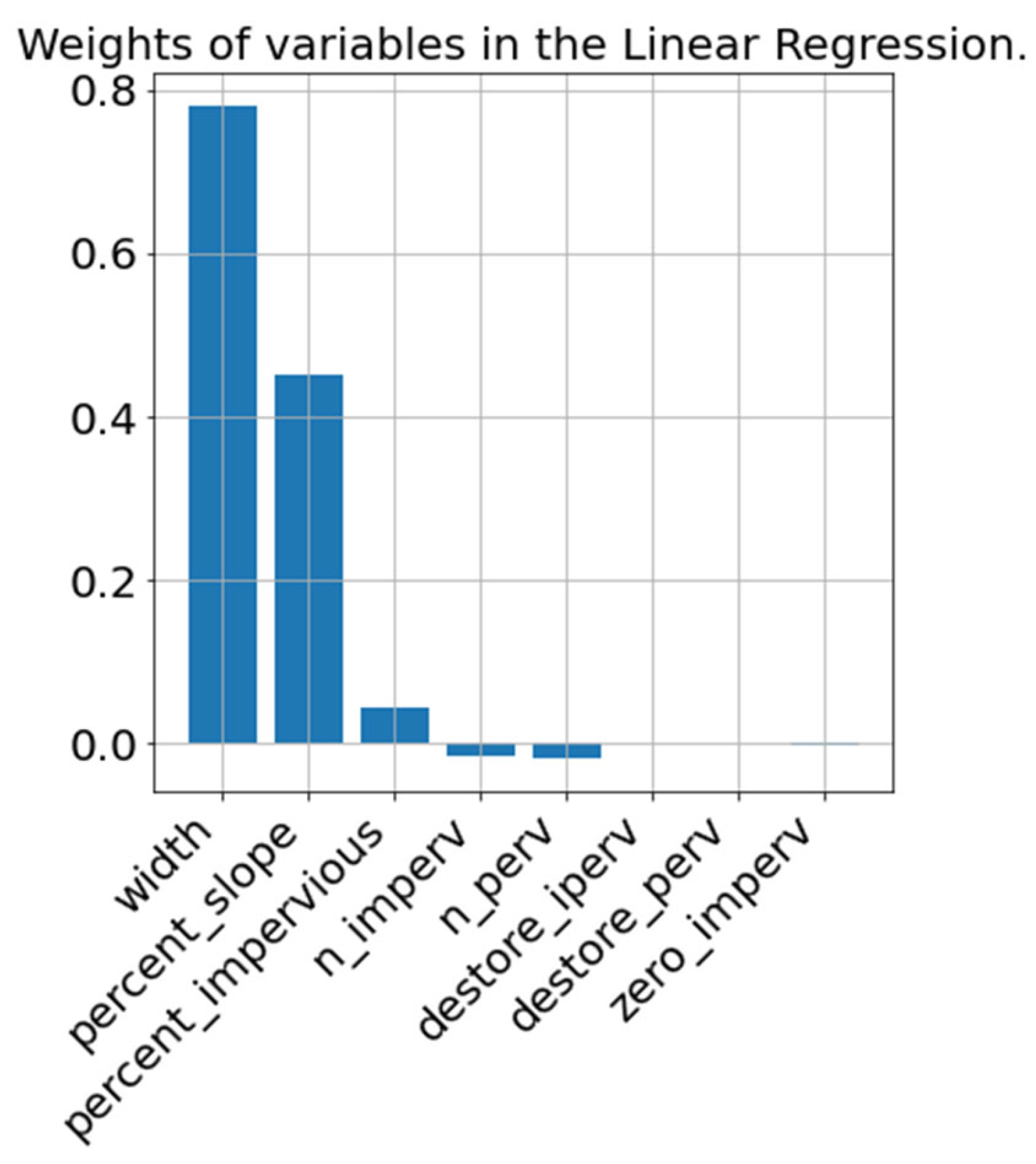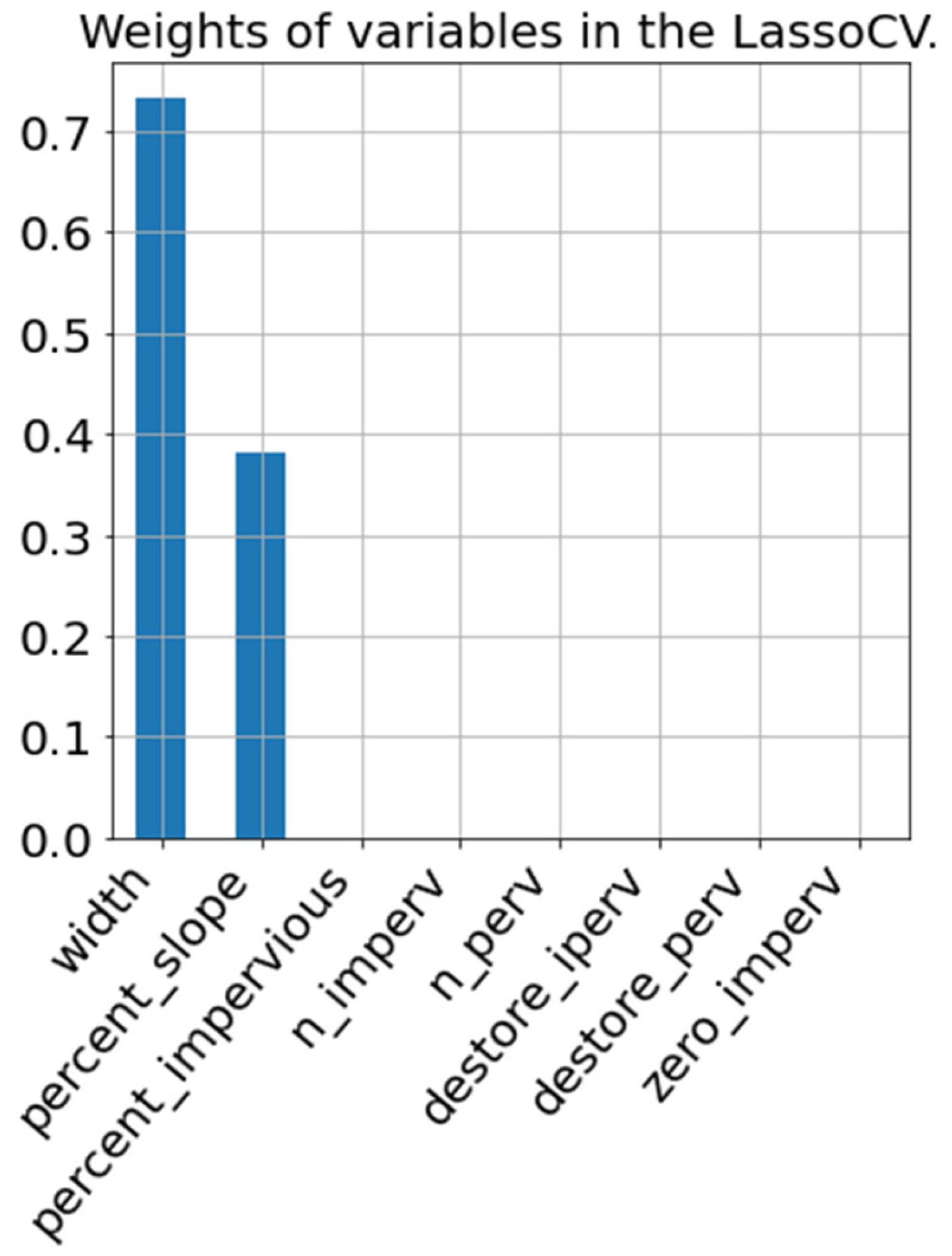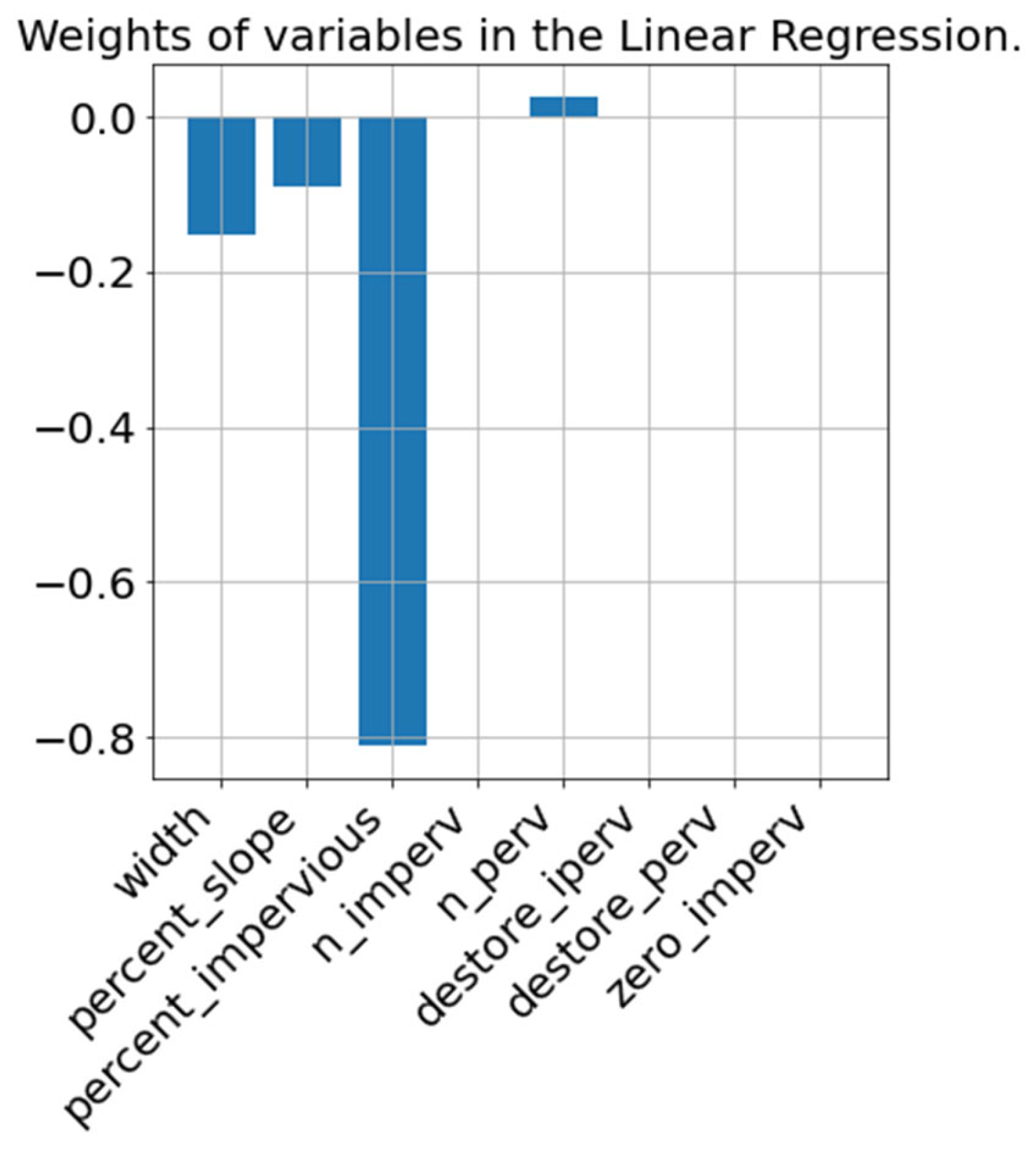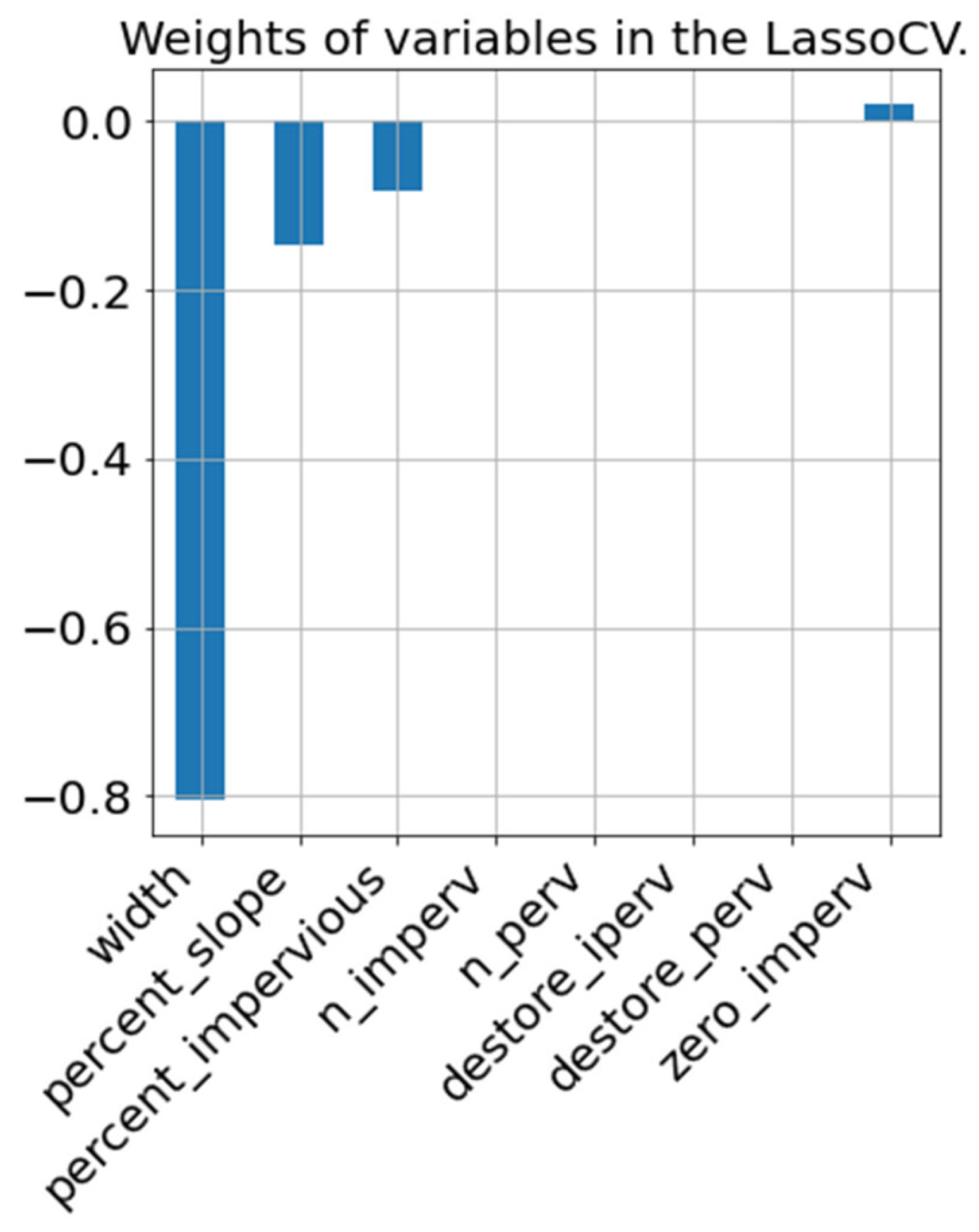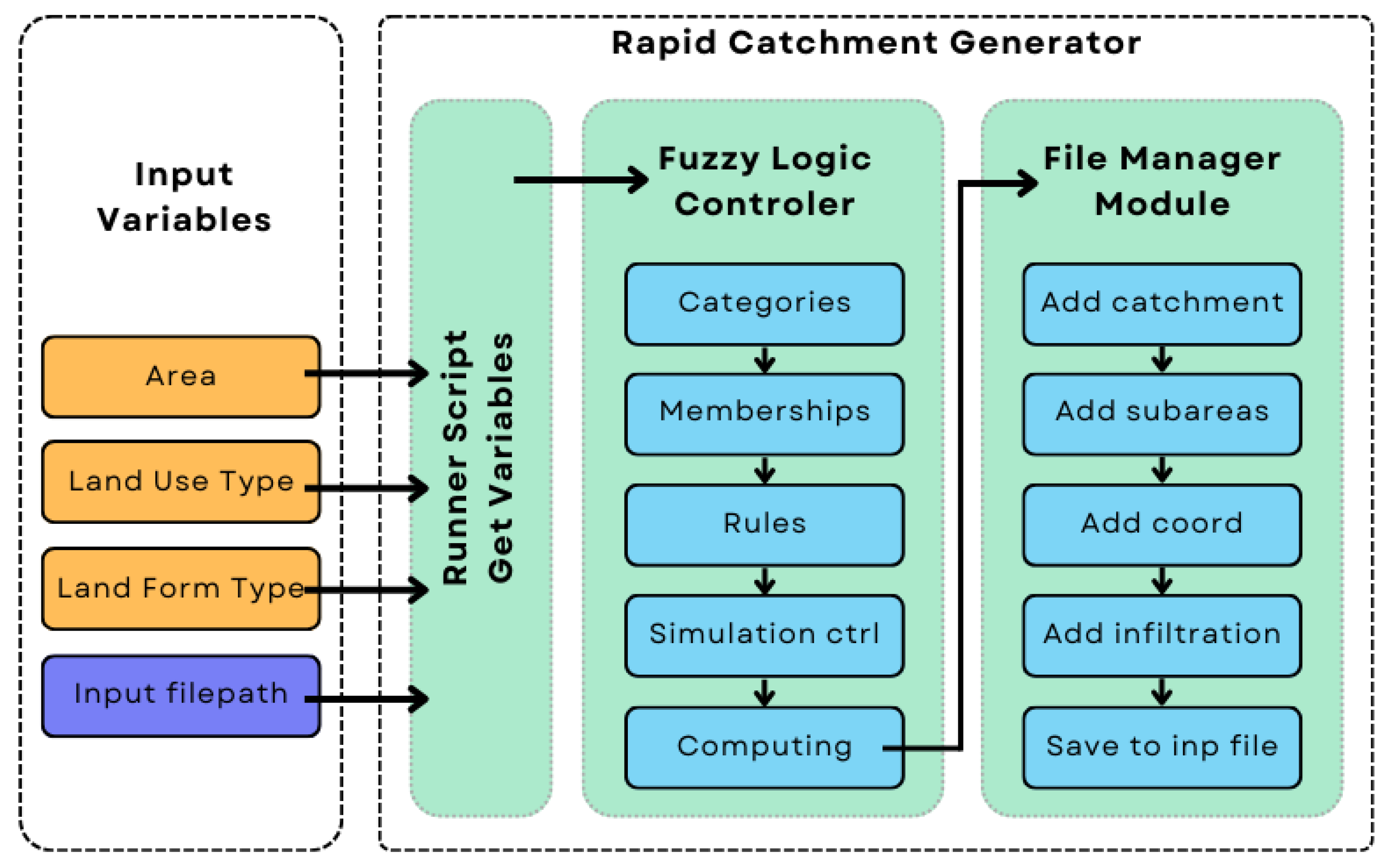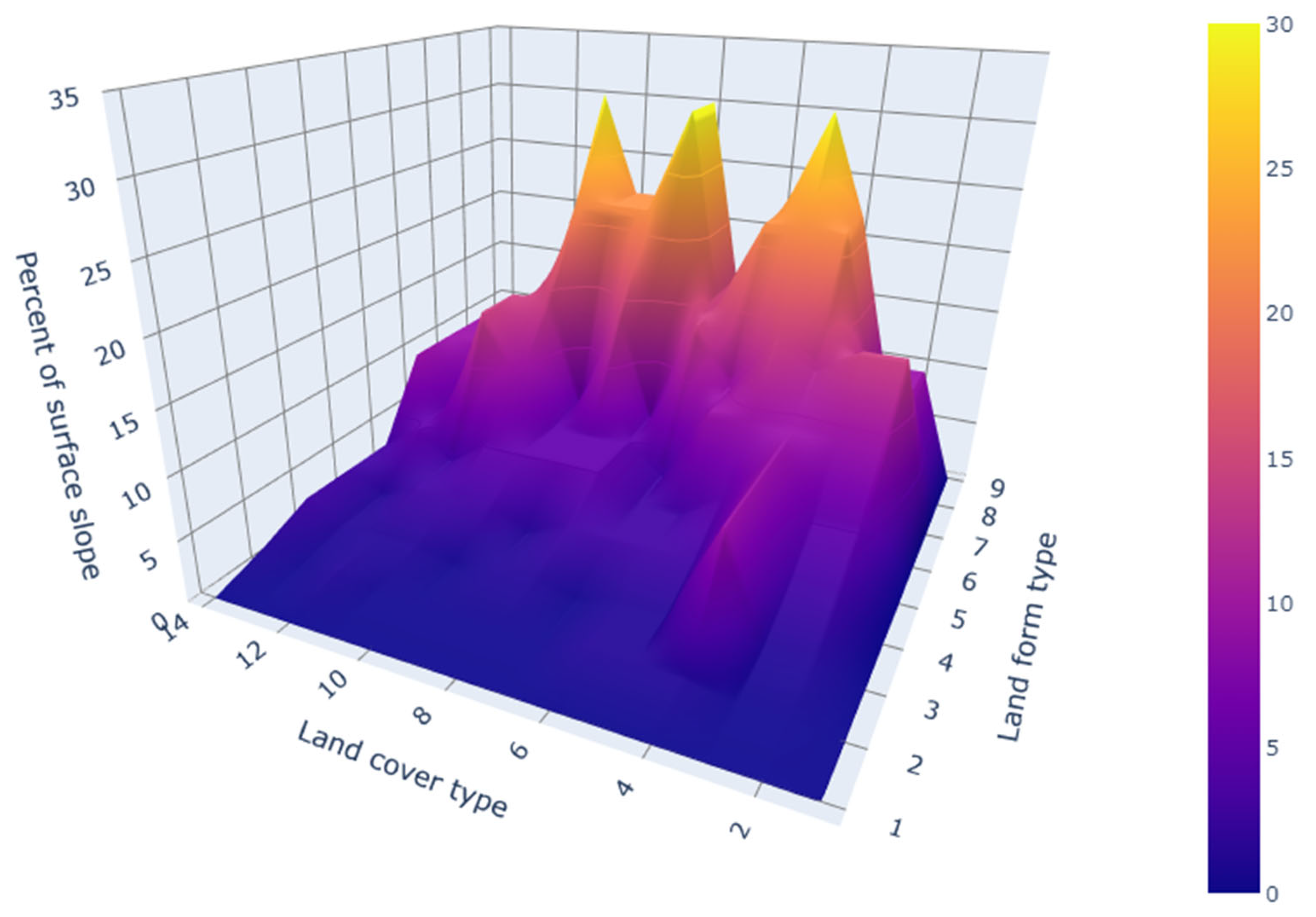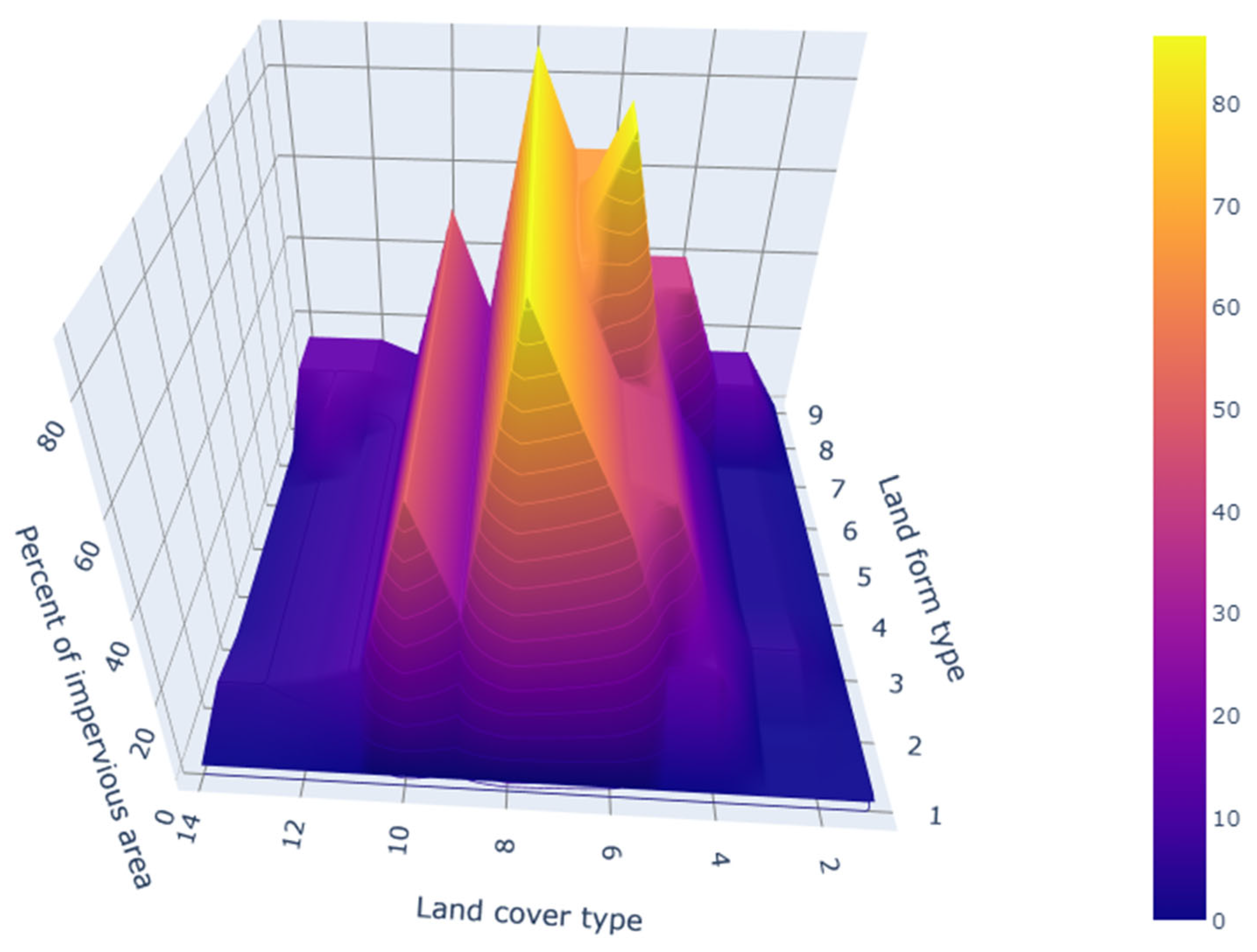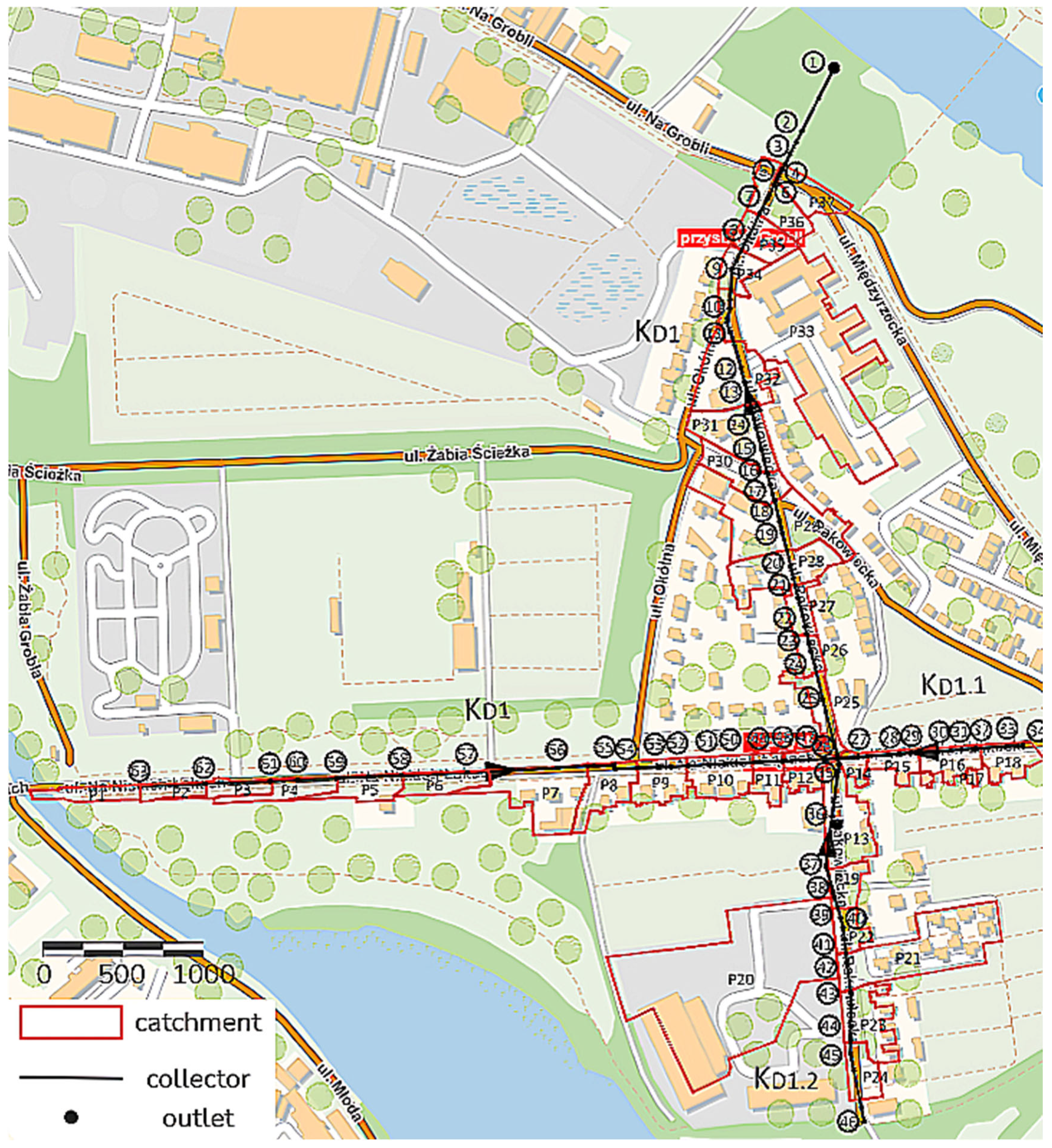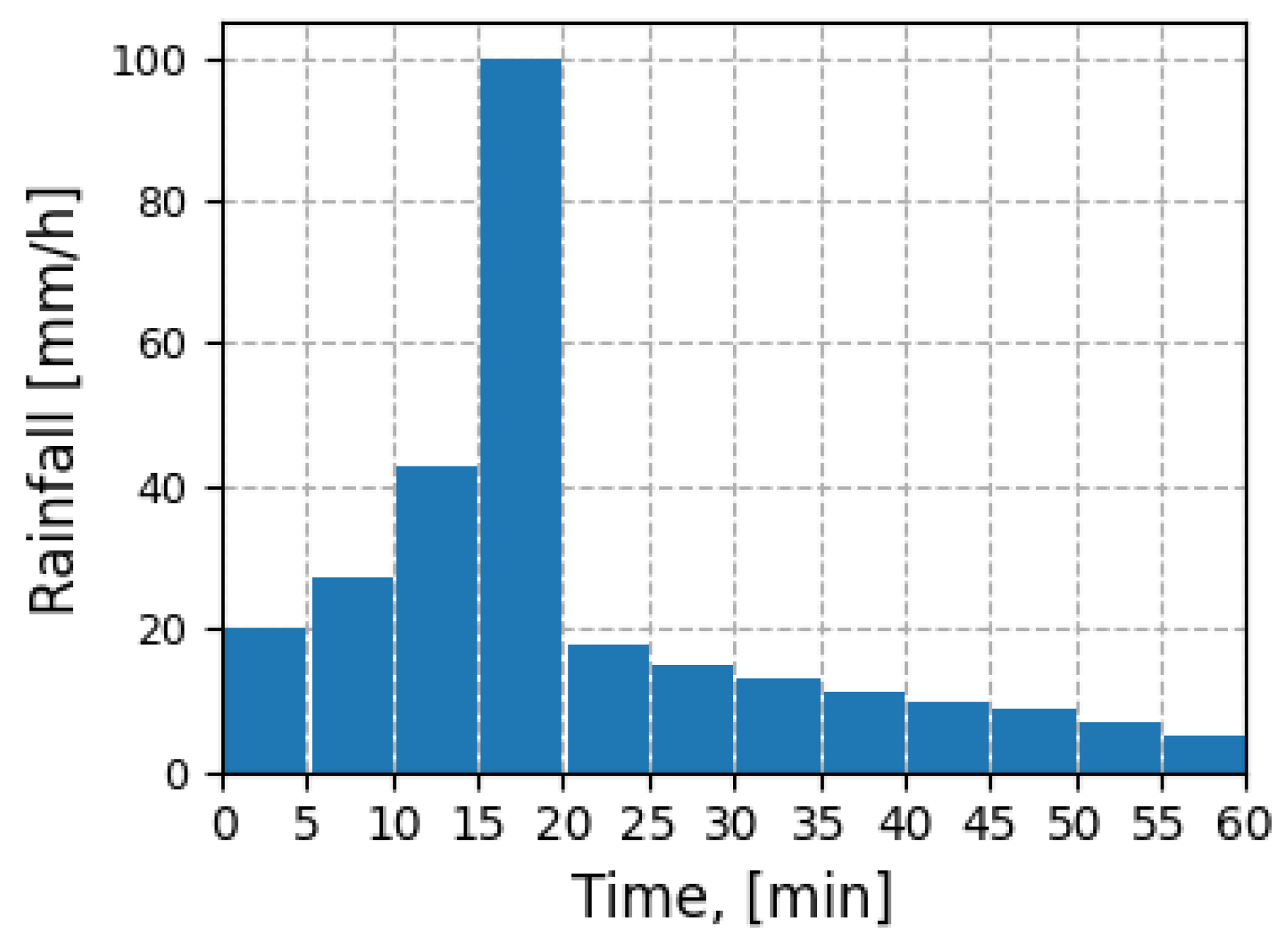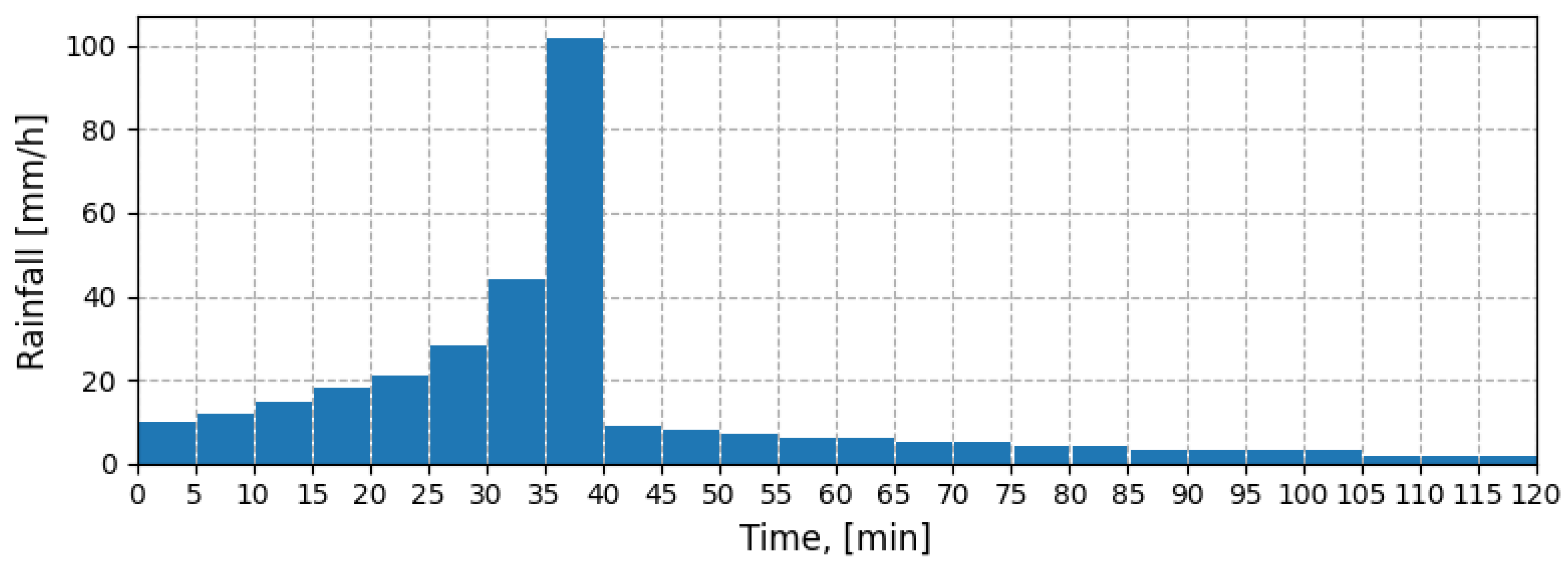1. Introduction
Sustainable urban development demands comprehensive management of water supply, wastewater, and stormwater systems. Stormwater management faces unique challenges because extreme rainfall events are inherently unpredictable and cannot be reliably inferred from historical patterns [
1]. Climate change further amplifies these challenges by intensifying precipitation extremes—recent studies project that urban runoff volumes could increase by up to 30% in many regions by 2055 [
2]. Consequently, modern stormwater infrastructure design must explicitly account for extreme events to ensure long-term resilience of urban drainage. Implementing engineering measures that reduce and detain runoff has been shown to improve the reliability and performance of stormwater systems [
3].
In response to these challenges, stormwater management practices have shifted from conventional “collect and convey” approaches toward more sustainable strategies tailored to different regions. The United Kingdom has widely adopted Sustainable Urban Drainage Systems (SUDSs) to mimic natural hydrological processes by integrating features such as permeable pavements, bioretention basins, and detention ponds into the built environment, thereby reducing runoff and improving water quality [
4]. Similarly, the United States promotes Low Impact Development (LID), which manages stormwater at its source through site-scale interventions such as rain gardens, green roofs, and rain barrels [
5]. Australia’s approach, Water Sensitive Urban Design (WSUD), takes a holistic view of the urban water cycle by incorporating stormwater management into broader land-use planning and resource management [
6]. Meanwhile, China’s ambitious Sponge City Programme (SCP) aims to retrofit cities with green infrastructure capable of absorbing, storing, and reusing up to 70% of rainwater on-site by 2030 [
7].
Although these programs are tailored to their local contexts and differ in scale—LID typically operates at the parcel or neighborhood level, whereas SCP is applied city-wide—they share the common goal of creating more resilient urban drainage systems. Local factors such as climate, existing infrastructure, and institutional capacity influence which approach is most suitable in a given region [
8], but all these sustainable strategies seek to adapt urban watersheds to shifting precipitation patterns while providing co-benefits such as improved water quality, enhanced green space, and mitigation of urban heat island effects. Assessing the performance of such interventions and identifying optimal solutions requires advanced modeling tools capable of simulating complex hydrological processes under diverse scenarios. In this context, the U.S. Environmental Protection Agency’s Storm Water Management Model (SWMM) has become a leading platform for urban stormwater planning due to its flexibility and comprehensive feature set [
9].
SWMM was first released by the U.S. Environmental Protection Agency in 1971 to support the design of combined-sewer systems [
10]. Subsequent versions incorporated water-quality simulation (late 1970s), real-time control capabilities (1980s), and a graphical user interface (1990s). The 2005 release of SWMM 5 introduced a dynamic-wave solver, object-oriented data structures, and—crucially—an open-source license that stimulated the development of supporting libraries such as PySWMM and SWMM-CAT [
9,
10]. Recent updates added native low-impact-development modules and climate-adjustment tools, establishing SWMM as the de facto standard for urban drainage simulation. Despite this progress, subcatchment parameterization still depends on manual interpretation of terrain and land cover—a bottleneck addressed in this study through the Rapid Catchment Generator.
Employing SWMM (or similar models) effectively requires careful selection of catchment parameters, a process that is both critical and challenging. Key subcatchment characteristics—such as slope, impervious cover, and catchment shape (often represented by an effective width parameter)—strongly influence runoff generation, infiltration, and the timing and magnitude of peak flows [
11,
12]. The accuracy of model predictions therefore depends on how well these parameters are chosen and calibrated to reflect real-world conditions [
13]. Manually calibrating a model to determine appropriate values can be labor-intensive and time-consuming, especially for large or complex catchments.
To ease this burden, researchers have developed various techniques to assist or automate the parameterization process. Geographic information system (GIS) tools can extract catchment attributes from spatial data, significantly streamlining model setup [
14,
15]. Machine learning algorithms have also been applied to calibrate or optimize parameters in heterogeneous urban catchments, improving model performance by learning from observed data [
16]. Additionally, new open-source libraries extend SWMM’s capabilities and facilitate rapid model building. For example, PySWMM provides a Python interface to SWMM, allowing users to programmatically adjust model data and even interact with simulations in real time [
17]. Another tool, SWMMIO, offers utilities for version control, result visualization, and treating SWMM data as data frames, enabling custom analyses and automated workflows. These advances make it easier to construct and experiment with models than was possible with SWMM’s graphical interface alone.
One notable GIS-based approach automatically delineated a large number of subcatchments for SWMM from open-access spatial data. Warsta et al. [
18] report that this method greatly accelerated model construction for urban areas, but the resulting SWMM input file contained so many small subcatchments that it became difficult to edit and calibrate using the standard SWMM interface. To mitigate this issue, Niemi et al. [
19] proposed merging areas with homogeneous land cover and drainage characteristics into single, larger catchments. This simplification reduced the total number of subcatchments and significantly sped up simulation times, making the models more tractable.
Despite such progress, many practical planning tools still provide only partial solutions and lack the flexibility of a full-featured modeling environment. For instance, the U.S. EPA’s National Stormwater Calculator (SWC) is useful for estimating the long-term runoff impacts of site-level stormwater controls, but it focuses on simplified, site-specific evaluations and does not generate detailed catchment models [
20]. Similarly, the Green Values Stormwater Management Calculator emphasizes the economic and environmental benefits of green infrastructure but offers limited capability to explore custom scenarios [
21]. LIDRA 2.0 provides quick assessments of low-impact development options without producing SWMM-compatible models or allowing integration into larger systems [
22]. Other specialized tools have been built around the SWMM engine to extend its functionality: StormReactor, for example, enables modeling of stormwater treatment processes and pollutant generation within drainage networks [
23], and the MatSWMM toolkit supports real-time control strategies for urban drainage design [
24]. Researchers have also explored advanced optimization techniques to improve stormwater system design; for example, Yang et al. [
25] developed a multi-objective optimization approach that uses machine-learning surrogate models (e.g., regression and neural networks) to efficiently identify optimal configurations of LID measures, thereby reducing computational requirements while maintaining accuracy in predicting outcomes.
However, integrating these innovations into routine planning workflows remains far from seamless. Building and calibrating a detailed SWMM is still a labor-intensive endeavor—studies report that initial setup can take from days to weeks depending on catchment size and complexity [
26]. This prolonged turnaround time severely limits the ability of engineers and planners to rapidly evaluate alternative design scenarios or to incorporate climate resiliency measures in the early stages of project planning. Moreover, adjusting models to account for climate change scenarios is cumbersome. Tools such as SWMM’s Climate Adjustment Tool (SWMM-CAT) make it possible to modify rainfall inputs for future conditions, but current workflows lack the ability to reconfigure catchment parameters quickly across multiple projected scenarios. Practitioners are often forced to choose between model fidelity and efficiency, sometimes oversimplifying representations of the system to save time at the risk of obscuring critical vulnerabilities. Additionally, effective model calibration requires specialized expertise that is not always available to local agencies or smaller organizations [
8]. This knowledge barrier makes advanced modeling less accessible for many communities and further slows the adoption of innovative stormwater solutions. Together, the high time investment and skill requirements often lead practitioners to default to conventional drainage designs that may be ill-suited to future urbanization and climate pressures.
One promising but underutilized approach to streamlining catchment modeling is the application of fuzzy logic. Fuzzy logic provides a framework for encoding qualitative expert knowledge as quantitative rules, which is valuable for hydrological modeling under uncertainty. Thus far, its use in mainstream urban drainage tools has been limited. Most applications of fuzzy logic in stormwater and runoff estimation have been experimental or site-specific—for instance, Barreto-Neto and de Souza Filho [
27] developed a fuzzy rule-based model to estimate runoff in a tropical watershed—while widely used platforms such as SWMM have seen little integration of fuzzy techniques for catchment setup. Bridging this gap between qualitative insight and model parameters could enable faster, more adaptive modeling by translating subjective judgments (e.g., about land characteristics or drainage behavior) into the inputs that engineering models require.
Despite significant advances in automated SWMM construction and parameter optimization, a critical gap remains in translating qualitative catchment descriptions into quantitative model parameters rapidly and accessibly. Existing tools either require extensive GIS data preprocessing, demand specialized expertise for calibration, or produce oversimplified models unsuitable for detailed analysis. While fuzzy logic has demonstrated promise in hydrological applications, its integration into mainstream urban drainage modeling workflows—particularly for SWMM catchment parameterization—remains largely unexplored. This paper addresses these limitations by presenting the RCG, a novel fuzzy logic-based tool that bridges the gap between expert hydrological knowledge and model parameterization. Unlike existing approaches that focus on either full automation with complex data requirements or simplified calculators with limited functionality, RCG enables practitioners to generate SWMM-ready catchment parameters from minimal qualitative inputs (area, landform type, and land cover type) within seconds. By codifying hydrological expertise into fuzzy rules and directly integrating with SWMM input files, this research demonstrates how fuzzy inference systems can transform the catchment modeling workflow—reducing setup time by orders of magnitude while maintaining the flexibility for subsequent detailed calibration. This approach not only democratizes access to advanced stormwater modeling but also provides a reproducible framework for rapid scenario testing essential for climate-resilient urban drainage design.
3. Results
To evaluate the performance of RCG 0.1.0, the test and generated catchments were compared. The test catchment, located in the Rakowiec Estate in Wrocław, Poland, covers approximately 10 hectares and features a mix of residential, commercial, and green spaces (
Figure 8). Bordered by the Odra and Oława Rivers, its drainage system discharges into the Odra River. Divided into 37 subcatchments (P1–P37), the test area reflects the diversity of land cover and topography within the estate. The simulation used two rainfall events based on the Euler II model, each with a three-year recurrence interval. The first event had a peak intensity of 102 mm/h and lasted 60 min (
Figure 9), while the second had a peak intensity of 102 mm/h and lasted 120 min (
Figure 10). These rainfall events represent real-world conditions that could significantly impact the drainage system’s capacity [
28].
The RCG utilizes linguistic variables to define catchment characteristics, which influence hydrological behavior.
Table 6 outlines the land use and landform categories assigned during the generation process. To replicate the test subcatchments using the RCG, each catchment labeled ‘Pn’ was paired with a generated equivalent, labeled ‘Gn’ (
Table 7). Runoff hydrographs for the 60-min and 120-min Euler II rainfall events are presented in
Figure 10 and
Figure 11, showing the peak runoff comparisons between the test and generated catchments. For validation, each calibrated subcatchment
Pn (where
n = 1…37) was paired with a generated counterpart
Gn of identical drainage area and outlet. This one-to-one mapping isolates the impact of parameter generation while holding catchment geometry constant.
During the 60-min design storm, the test basin generated 126 m3/ha of runoff, 92.4 m3/ha of infiltration, and a peak discharge of 0.10 m3/s/ha. The generated basin yielded 140.1 m3 ha−1, 88.8 m3 ha−1, and 0.147 m3 s−1 ha−1, respectively. This corresponds to Mean Absolute Percentage Errors (MAPEs) of 15.9% for runoff, 19.2% for infiltration, and 37.7% for peak flow. A similar pattern was observed in the 120-min storm (runoff MAPE 15.7%, infiltration MAPE 19.2%, peak flow MAPE 29.4%).
3.1. Volume Validation
Agreement between test and generated time series was quantified with Nash–Sutcliffe efficiency (NSE), coefficient of determination (R
2), percent bias (PBIAS), root mean square error (RMSE), and the above MAPE values (
Table 8).
Runoff metrics indicate excellent skill: NSE ≈ 0.92, R
2 = 0.99, and volume MAPE ≈ 16%. A positive PBIAS of about +11% confirms the conservative overprediction already noted. Infiltration shows similarly strong performance (NSE = 0.91, R
2 = 0.94) with a small negative PBIAS (~−4%). All statistics fall within the “very good” range recommended for preliminary urban-drainage analyses [
62].
3.2. Peak-Flow Bias
Figure 11 and
Figure 12 show that generated hydrographs peak earlier and higher than test hydrographs. This bias originates from the square-footprint assumption, which yields greater hydraulic width than is typical for elongated urban catchments. Reducing width in a sensitivity test lowered peak-flow MAPE below 15% while leaving volume metrics in
Table 8 virtually unchanged, confirming that width had a decisive impact.
Figure 11.
Runoff hydrographs for the 60-min Euler Type II rainfall event, comparing the test catchments (P1–P37) and the generated catchments (G1–G37). The generated catchments show a higher and earlier peak runoff due to a larger Width parameter, which accelerates the concentration of runoff. The similarity in overall hydrograph shapes indicates effective replication of hydrological responses by the generated catchments under shorter-duration, high-intensity rainfall.
Figure 11.
Runoff hydrographs for the 60-min Euler Type II rainfall event, comparing the test catchments (P1–P37) and the generated catchments (G1–G37). The generated catchments show a higher and earlier peak runoff due to a larger Width parameter, which accelerates the concentration of runoff. The similarity in overall hydrograph shapes indicates effective replication of hydrological responses by the generated catchments under shorter-duration, high-intensity rainfall.
4. Conclusions
The SWMM tool offers an accurate approach to modeling rainfall events within catchment areas by considering parameters that realistically represent real-world conditions. The analysis of catchment features reveals that the width of the flow path, slope, and imperviousness are the most significant factors affecting runoff from the catchment.
The catchment generator was built based on the feature analysis conducted and surface runoff studies available in the literature. Parameterized categories of land cover and landforms were used as a basis for preparing fuzzy logic controller rules. Mapping typical storage and Manning’s coefficients simplified the catchment configuration process. The use of fuzzy logic rules allows modification of the system to adapt the categories to specific conditions. The construction of membership functions makes it possible to improve the accuracy of calculations and adapt the tool for different uses. Accurate representation of the actual condition of the catchment is possible through subsequent editing of the catchment in the SWMM GUI; no difficulties were observed with editing the *.inp file.
Performance analysis demonstrates that fuzzy logic effectively models and represents expert knowledge in hydrological systems. However, the results also reveal a consistent overestimation pattern in the generated catchments’ runoff values compared to the test catchment. With Mean Absolute Percentage Error (MAPE) values of 15–16% for runoff and approximately 19% for infiltration, the generated catchments closely approximate the hydrological behavior of the test catchment. Nevertheless, the higher MAPE values for peak runoff—37.7% for the 60-min event and 29.4% for the 120-min event—indicate a significant discrepancy in peak flow rates. At the concept stage, this conservative overprediction is acceptable, even desirable, because oversizing conduits is safer than undersizing them; however, peak-flow bias should be removed before detailed design.
The differences in peak runoff values are primarily attributed to the larger Width parameter calculated for the generated catchments. RCG assumes square-shaped catchments (as detailed in
Table 5), resulting in a calculated width that does not accurately represent urban catchments with numerous paved streets and walkways. In urban environments, these impervious surfaces channelize runoff, leading to faster flow paths and higher peak runoff rates. The simplified assumption of square catchments in the RCG may not capture this complex drainage effectively, leading to the observed overestimation of peak runoff in the generated catchments.
Additionally, these discrepancies can be attributed to certain limitations of the RCG. One such limitation is the maximum imperviousness value that the RCG can assign. For example, the test catchment P17 has 100% impervious surfaces, whereas the generated catchment G17 has a maximum imperviousness of 86.7%, which is the highest value the RCG can generate based on its internal settings (as outlined in
Figure 3). This limitation prevents the RCG from fully replicating catchments that are entirely urbanized or have fully paved surfaces. Consequently, this leads to underestimations in runoff volumes in highly impervious areas, as the model cannot assign values above the predefined maximum. Another limitation is related to the slope values. The test catchments have slope values ranging from 0.1% to 0.5%, while the RCG’s minimum slope value is 0.33%, as per the defined categories (see
Figure 2). This means that the RCG is unable to generate catchments with the lowest slope values observed in the test catchments, potentially affecting the accuracy of runoff predictions in areas where gentle slopes dominate. Consequently, this limitation might lead to slight overestimations of flow velocity and runoff in flatter catchments, where lower slopes should slow down overland flow and allow for more infiltration.
Despite these limitations, the RCG fulfills its primary function as a tool for rapid prototyping of catchments. It provides a quick and efficient means to generate catchment models based on general land use and landform categories. However, the generated catchments require calibration and careful consideration of specific hydrological parameters, such as surface imperviousness, slope, and flow path geometry. These adjustments are necessary to enhance the accuracy of the models, particularly in urban environments where complex flow patterns and highly impervious surfaces are common. Therefore, while RCG serves as a valuable starting point for hydrological analysis, it should be viewed as a precursor to more detailed modeling efforts that incorporate site-specific data and refinements.
The proposed catchment generator has proven to be an effective tool for rapid SWMM prototyping, cutting model setup time from hours to seconds. Written in Python and relying only on open-source libraries such as SWMMIO and Scikit–Fuzzy, it remains accessible to a broad range of users. Future work will extend the fuzzy-logic rule base with an optional low-impact development (LID) layer, allowing users to prototype source control scenarios without any manual edits to the model file. Planned tests will also vary precipitation intensity and duration and incorporate additional land use types.
While this study focused on the “flats and plateaus” landform type, the fuzzy logic controller can accommodate nine different landform categories. Exploring other categories, such as “lowlands” or “mountains”, could reveal different runoff characteristics and calibration needs. For instance, using steeper terrain may introduce slope-related challenges that were not addressed in this study. As such, additional calibration steps may be necessary to evaluate the model’s performance across different landforms. These terrains, often with more complex hydrological behaviors, could present new challenges in mapping watershed characteristics. While the model has performed well for “flats and plateaus”, further exploration across other categories would provide a more comprehensive understanding of its strengths and limitations. Expanding to other landform types would also offer opportunities to optimize the model’s ability to map linguistic variables to numerical values.
